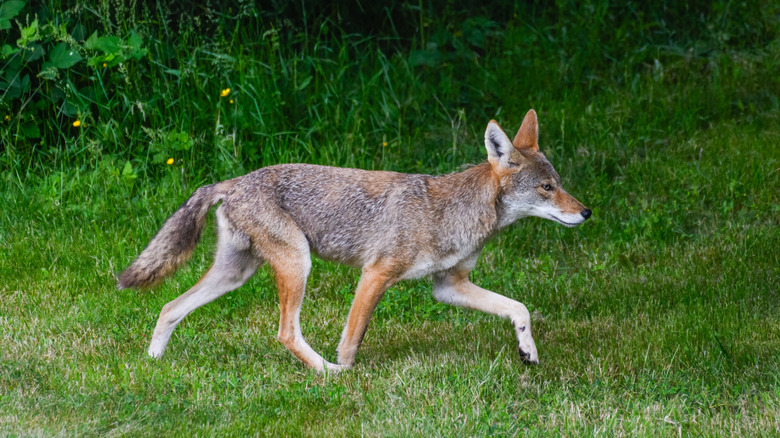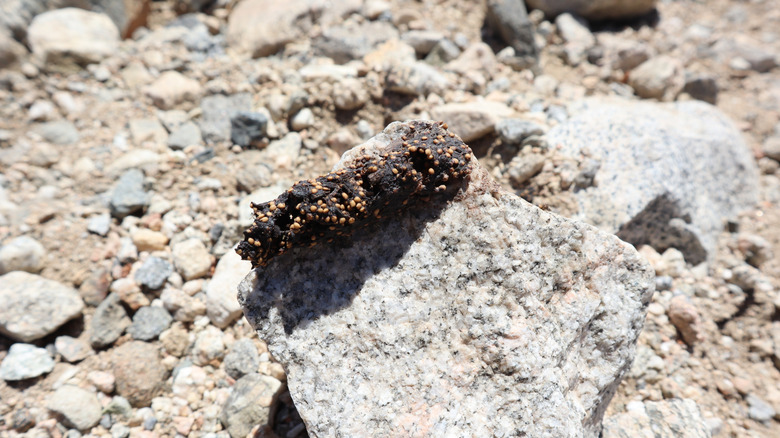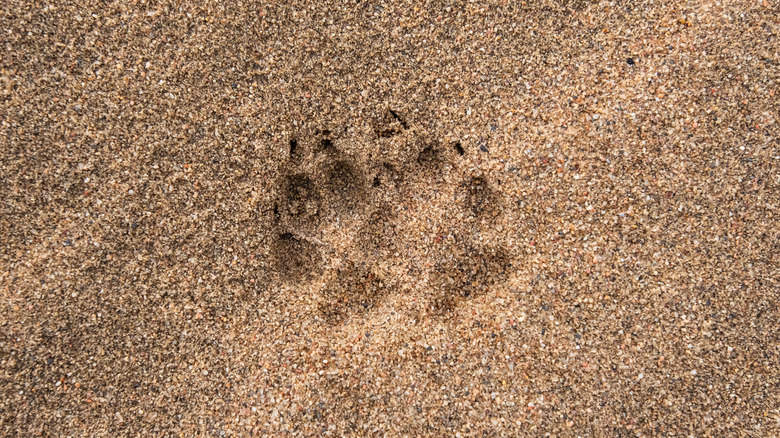Watch Out For These Signs Coyotes Are Roaming Your Backyard To Keep Your Dog Safe
We may receive a commission on purchases made from links.
If real coyotes behaved like Wile E. Coyote with an obsession exclusively for roadrunners, dog owners would have one fewer thing to worry about when letting their four-legged friends outside. In the real world, these omnivorous wild canines feast on whatever they can find, and unfortunately, that sometimes means someone's pet dog. Some pet owners aren't even aware that coyotes pose a threat in their neighborhoods. Knowing the audible and physical signs to look for is one of the ways to keep your dog safe from the dangers posed by coyotes.
The most obvious sign that a coyote or pack is near your home, aside from seeing one, is hearing their eerie howling and yipping. These vocalizations often sound like a dozen puppies in a state of distress, but coyotes make these noises to communicate with each other, mostly at night. It's common for people to be awoken and alarmed by "coyote conversations." If the sounds seem especially loud, it's likely that the coyotes are very close to your home. They could even be roaming around in your yard if you don't have a fence or if you have one shorter than 6 feet. Another sign of coyote presence in your yard are the visible traces left behind on your lawn.
Coyotes leave scat to mark their territory
You might have seen coyote fecal droppings, also known as scat, during a hike with your dog without knowing what animal it came from. Others aren't even aware that it's feces, so they don't give it another thought, but if you see any in your yard, you definitely don't want to shrug it off. You obviously know what your dog's feces looks like, but coyote scat doesn't quite look the same. The biggest difference between the two is that coyote droppings include obvious residue from their last meals.
Remember, coyotes are omnivores, so they eat everything we humans eat, but in raw form. That means you might see a mixture of hair, fur, and bone fragments in the droppings. It's sometimes described as rope-like and segmented. Depending on the fur color of the prey, the scat might be mostly white, brown, or gray in color. If the coyote recently enjoyed a mostly or entirely vegetarian diet with its last few meals, you might notice berries or seeds in the scat.
If you find coyote feces or any other wild animal droppings in your yard, take proper safety precautions to discard it. Use a designated poop scooper or shovel, or pick it up by hand while wearing disposable gloves, using layered grocery bags as a glove, or both. You should also wear a mask. Place the scat in a plastic bag, seal it, and throw it in an outdoor trash bin. Alternatively, you may want to contact a wildlife professional to assist.
You can spot coyote tracks in grassless areas
Adult coyotes can weigh 20 to 50 pounds, just like many small and medium dog breeds, so they can easily leave paw prints if the ground is soft enough. Unless you have a dog that's about the same size as a coyote, it should be easy to determine if any tracks in your yard are foreign. In either case, it's important to know the characteristics of a coyote print to look for.
While it's easy to tell the difference between cat and dog paw prints, it may be harder to spot a coyote's. Coyote tracks are more oval than a dog's prints and are about 2.5 inches or less in length. A notable difference lies in the direction that the pads face. In a dog paw print, you'll likely see the outer two pads form a V pattern when you include the metacarpal pad (the biggest pad at the bottom). A coyote's first and fourth pads, however, both point upward and form more of a U pattern with the metacarpal pad.
If you notice what you're certain or suspect to be coyote tracks in your yard, consider installing a fence or making your existing one taller. Eliminate any food sources that might be luring coyotes to your turf and claiming it as their own; secure your trash bin, make sure the bags are sealed, and remove bird or squirrel feeders. You may also want to purchase motion-activated lights to deter coyotes or a coyote spike vest for small dogs, like the CoyoteVest SpikeVest, to protect your dog from an attack — or both. With vigilance and a few precautionary steps, you can keep your dog safe from coyotes.


